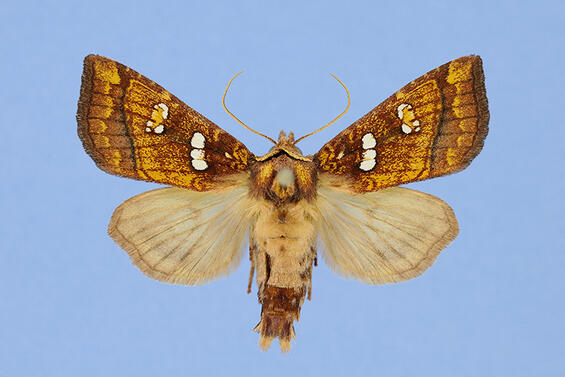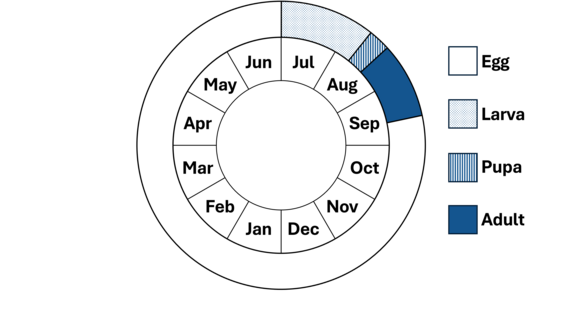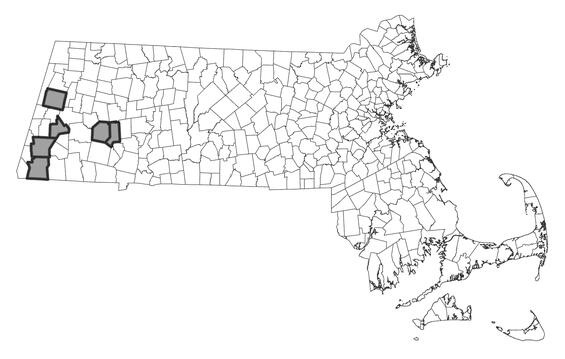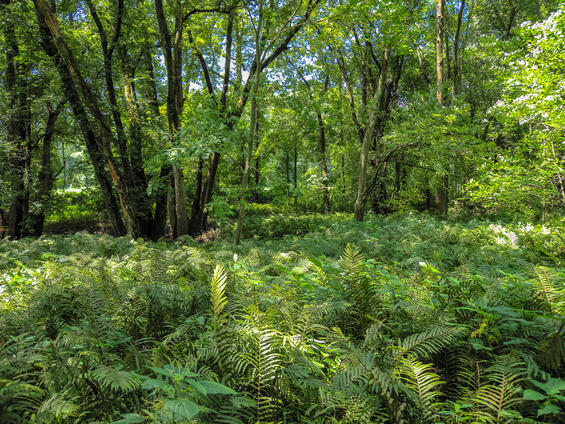- Scientific name: Papaipema sp. 2 near pterisii
- Species of Greatest Conservation Need (MA State Wildlife Action Plan)
- Special Concern (MA Endangered Species Act)
Description

Ostrich fern borer, Papaipema sp. 2 near pterisii
Not formally described in published scientific literature, the ostrich fern borer (Papaipema sp. 2 near pterisii) is a noctuid moth with a wingspan of 32-36 mm (1.3-1.4 in). The forewing is bright orange-yellow overlaid with darker brownish-orange, sometimes with pink shading toward the outer margin. The terminal area is more uniformly brownish-orange, with a bright, orange-yellow subterminal line that is diffuse and irregular, widening toward the apex. The postmedial line is double, brownish-orange proximally and dark brown to black distally. There may be a single, straight median line and double, wavy antemedial and basal lines, all brownish-orange in color, but these are often obscured by the surrounding brownish-orange of the median and basal areas. The reniform spot is large and elliptical, white with an orange-yellow center; the orbicular spot is relatively round and white, often merged with the elliptical, white claviform spot immediately below. The hind wing is tan, slightly tinged with pink; a faint discal spot may be present. The elongate scales of the head and thorax are a variable mixture of brownish-orange to orange-yellow, matching the overall coloration of the forewing; the abdomen is tan, slightly tinged with pink, matching the overall coloration of the hind wing. The bracken borer (Papaipema pterisii) is very similar, but on average the ostrich fern borer is larger in size and darker in color. The larval host plants and habitat preferences of the two species are also different.
Life cycle and behavior
In Massachusetts, ostrich fern borer moths fly from mid-August through mid-September. Eggs overwinter and hatch in early summer. Larvae bore into and feed on the stems and roots of ostrich fern (Matteuccia struthiopteris), becoming fully grown and pupating in August.

Distribution and abundance
The ostrich fern borer has a relatively small range that extends from Vermont south to Connecticut, and west to Pennsylvania and Wisconsin (NatureServe 2025). In Massachusetts, the ostrich fern borer is known from Berkshire and western Hampshire and Hampden Counties.

Distribution in Massachusetts.
1999-2024
Based on records in the Natural Heritage Database.
Habitat
In Massachusetts, the ostrich fern borer inhabits floodplain forest and wooded swamps with ostrich fern (Matteuccia struthiopteris).
Healthy habitats are vital for supporting native wildlife and plants. Explore habitats and learn about conservation and restoration in Massachusetts.

Floodplain forest with abundant ostrich fern (Matteuccia struthiopteris), ideal habitat for the ostrich fern borer.
Threats
The ostrich fern borer is threatened by habitat loss and hydrologic alteration that disrupts the natural flooding of its habitat. Other potential threats include invasion by exotic plants, clear-cut timber harvest, eutrophication or other water pollution, riverbank stabilization, aerial insecticide spraying, non-target herbicide application, and off-road vehicles. The ostrich fern borer has a narrow latitudinal range, likely making it vulnerable to a warming climate. Northward range expansion may be possible, though this has not yet been documented.
Conservation
Land protection and habitat management are the primary conservation needs of the ostrich fern borer in Massachusetts. In particular, floodplain forest and wooded swamps with ostrich fern should be conserved, restored, and managed to maintain habitat for this species and other species dependent on such habitat.
Survey and monitoring
The distribution of the ostrich fern borer in Massachusetts is relatively well documented. Known populations of this species should be surveyed to document persistence at least once every 25 years; every 10 years is more desirable when practicable.
Management
Management of floodplain forest and wooded swamps with ostrich fern should include restoring and/or maintaining natural hydrology and control of invasive exotic plants. Habitat condition should be monitored and management adapted as needed.
Research needs
The natural history and conservation needs of the ostrich fern borer are relatively well known. However, the future effects of a warming climate on this species are unpredictable and should be documented.
References
NatureServe. 2025. NatureServe Network Biodiversity Data accessed through NatureServe Explorer [web application]. NatureServe, Arlington, Virginia. Available https://explorer.natureserve.org/. (Accessed: February 12, 2025).
Contact
| Date published: | March 24, 2025 |
|---|